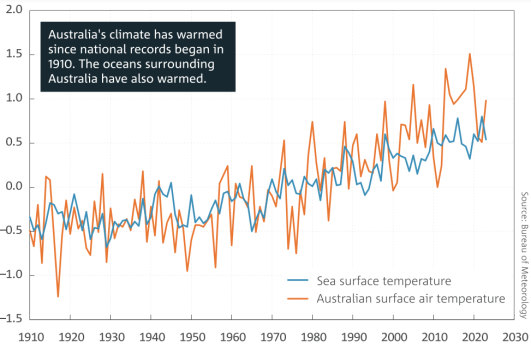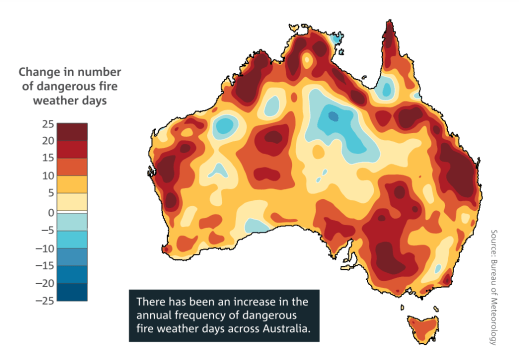As Australia’s climate continues to change, the country is recording drier conditions, extended bushfire seasons and intense heavy rainfall – according to new data.
Released this week by the CSIRO and the Bureau of Meteorology, the State of the Climate 2024 shows Australia has warmed on average by 1.51°C from 1910 to 2023. “The warming has led to an increase in the frequency of extreme heat events over land and in the oceans,” says the report. The report warns that warming in Australia is projected to continue.

The biennial report also shows sea levels are rising around Australia, “including more frequent extreme high levels that increase the risk of inundation and damage to coastal infrastructure and communities”.
Meanwhile, average sea surface temperatures in the region have warmed by 1.08 °C since 1900, with nine of the 10 warmest years on record occurring since 2010. As the report’s authors note, this rate of warming is close to that of the global mean sea surface temperature.
Australia has also recorded an increase in extreme fire events – especially in the south. These events will become more frequent and last longer, says the report.

Australia has seen a shift towards drier conditions across the south-west and south-east of the country, with more frequent periods of below-average rainfall. “The recent drying across these regions is the most sustained large-scale change in observed rainfall since widespread observations became available in the late 1880s,” says the report.
Observations also show an increase in the intensity of heavy rainfall events in Australia. “The intensity of short-duration extreme rainfall events has increased by around 10% or more in some regions and in recent decades, with the largest increases typically observed in the north of the country,” says the report.
In conclusion, the report’s authors say: “Changes to our climate affect all Australians, particularly the changes associated with increases in the frequency or intensity of heat events, fire weather and drought. Australia will need to plan for and adapt to climate change.”
In response to the findings, federal minister for industry and science Ed Husic said: “This report makes for difficult reading.”
Minister for the environment and water Tanya Plibersek said the report confirms what is already known – “That there are huge challenges facing Australia from a changing climate.”
Chris Bowen – minister for climate change and energy – said the report reiterates the urgent need to act. “The experts could not be clearer – we are seeing more extreme weather events, longer fire seasons, more intense rainfall and sea level rise, and this will only get worse without real actionable plans to drive down emissions.”





Can the government explain why there are numerous planes seen overhead spraying chemicals into the atmosphere with extrarordinaraily long tails?1-5 kilometres? These are not condensation from plane jet exhaust, as they dissipate within a few hundred metres of the plane and comlpetely dissappear within minutes, any plane captain will attest to this fact. These long tails are kilometres long, thick and dissolve gradually into the atmosphere over many hours. There seems to be a correlation between these activities prior to heavy and randomised rain periods across a multitide of cities and states in Australia? Can the government provide a detailed report into what is being released from these planes and why?